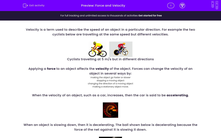Velocity is a term used to describe the speed of an object in a particular direction. For example the two cyclists below are travelling at the same speed but different velocities.
.jpg)

Cyclists travelling at 5 m/s but in different directions.
Applying a force to an object affects the velocity of the object. Forces can change the velocity in the following ways:
- making the object go faster or slower
- stopping a moving object
- changing the direction of a moving object
- making a stationary object move.
When the velocity of an object, such as a car, increases, then the car is said to be accelerating.

When an object is slowing down, then it is decelerating. The ball shown below is decelerating because the force of the net against it is slowing it down.

Sir Isaac Newton stated in his Laws of Motion that, if there are no forces acting on an object, then:
- If the object is at rest, it will remain at rest.
- If the object is moving, it will continue to move at a steady speed in a straight line.
These laws can be tested in space, because there is no air in space to affect the movement of the objects.
Imagine that you accelerate to 200 miles per hour in a space ship in space, then you turn off the engines. The space ship will continue to travel at 200 miles per hour forever because there are no forces, such as air resistance acting on the space ship.

On Earth, there are forces such as air resistance and friction that slow moving objects down.
Let's try some questions now.








